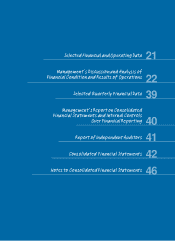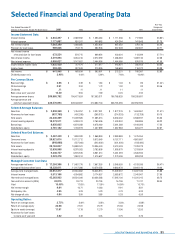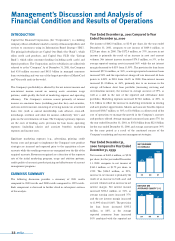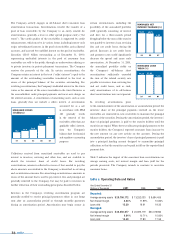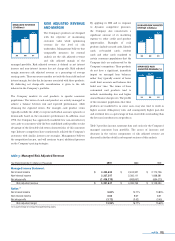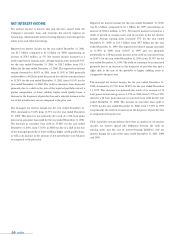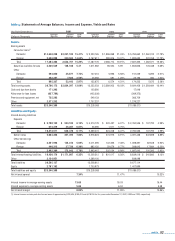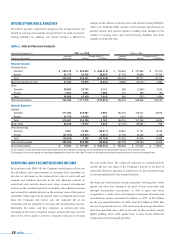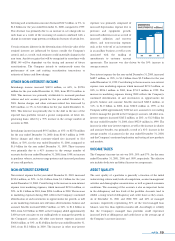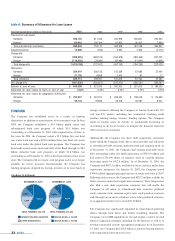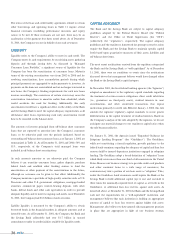Capital One 2001 Annual Report Download - page 26
Download and view the complete annual report
Please find page 26 of the 2001 Capital One annual report below. You can navigate through the pages in the report by either clicking on the pages listed below, or by using the keyword search tool below to find specific information within the annual report.
The Company actively engages in off-balance sheet consumer loan
securitization transactions. Securitizations involve the transfer of a
pool of loan receivables by the Company to an entity created for
securitizations, generally a trust or other special purpose entity (“the
trusts”). The credit quality of the receivables is supported by credit
enhancements, which may be in various forms including interest-only
strips, subordinated interests in the pool of receivables, cash collateral
accounts, and accrued but unbilled interest on the pool of receivables.
Securities ($24.3 billion outstanding as of December 31, 2001)
representing undivided interests in the pool of consumer loan
receivables are sold to the public through an underwritten offering or
to private investors in private placement transactions. The Company
receives the proceeds of the sale. In certain securitizations, the
Company retains an interest in the trust (“seller’s interest”) equal to the
amount of the outstanding receivables transferred to the trust in
excess of the principal balance of the securities outstanding. For
revolving securitizations, the Company’s undivided interest in the trusts
varies as the amount of the excess
receivables in the trusts fluctuates as
the accountholders make principal payments and incur new charges on
the selected accounts. A securitization of amortizing assets, such as auto
loans, generally does not include a seller’s interest. A securitization
accounted for as a sale
in accordance with SFAS
140 generally results
in the removal of the
receivables, other than any
applicable seller’s interest,
from the Company’s
balance sheet for financial
and regulatory accounting
purposes.
Collections received from securitized receivables are used to pay
interest to investors, servicing and other fees, and are available to
absorb the investors’ share of credit losses. For revolving
securitizations, amounts collected in excess of that needed to pay the
above amounts are remitted to the Company, as described in servicing
and securitizations income. For amortizing securitizations, amounts in
excess of the amount that is used to pay interest, fees and principal are
generally remitted to the Company, but may be paid to investors in
further reduction of their outstanding principal as described below.
Investors in the Company’s revolving securitization program are
generally entitled to receive principal payments either in one lump
sum after an accumulation period or through monthly payments
during an amortization period. Amortization may begin sooner in
certain circumstances, including the
possibility of the annualized portfolio
yield (generally consisting of interest
and fees) for a three-month period
dropping below the sum of the security
rate payable to investors, loan servicing
fees and net credit losses during the
period. Increases in net credit losses
and payment rates could significantly
decrease the spread and cause early
amortization. At December 31, 2001,
the annualized portfolio yields on
the Company’s off-balance sheet
securitizations sufficiently exceeded
the sum of the related security rate
payable to investors, loan servicing fees
and net credit losses, and as such,
early amortizations of its off-balance
sheet securitizations were not expected.
In revolving securitizations, prior
to the commencement of the amortization or accumulation period, the
investors’ share of the principal payments received on the trusts’
receivables are reinvested in new receivables to maintain the principal
balance of the securities. During the amortization period, the investors’
share of principal payments is paid to the security holders until the
securities are repaid. When the trust allocates principal payments to the
security holders, the Company’s reported consumer loans increase by
the new amount on any new activity on the accounts. During the
accumulation period, the investors’share of principal payments is paid
into a principal funding account designed to accumulate principal
collections so that the securities can be paid in full on the expected final
payment date.
Table 2 indicates the impact of the consumer loan securitizations on
average earning assets, net interest margin and loan yield for the
periods presented. The Company intends to continue to securitize
consumer loans.
24 md&a
table 2: Operating Data and Ratios
Year Ended December 31
(Dollars in Thousands) 2001 2000 1999
Reported:
Average earning assets $20,706,172 $ 13,252,033 $ 9,694,406
Net interest margin 8.03% 11.99% 10.86%
Loan yield 15.29 19.91 19.33
Managed:
Average earning assets $38,650,677 $ 24,399,119 $20,073,964
Net interest margin 9.04% 10.71% 10.83%
Loan yield 15.48 17.83 17.59








